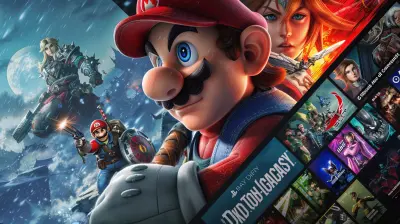The Evolution of Arcade Gaming: From Pixel to Power
7 October 2025
Ah, arcade gaming. Just the mention of it sends a wave of nostalgia through anyone who’s ever stood in front of a glowing cabinet, clutching a joystick, and mashing buttons like their life depended on it. It’s hard to believe that the games we casually play on our smartphones today evolved from those pixel-packed machines of yesteryear. But how did we get from those humble pixels to the mind-blowing, immersive experiences we have now? Let’s take a trip down memory lane and unpack the fascinating evolution of arcade gaming, step by step, one pixel at a time.![]()
Beginnings: The Pixelated Pioneers
The story of arcade gaming starts in the early 1970s, a simpler time when video games were just beginning to emerge as a cultural phenomenon. One of the first arcade games to make a splash was Pong—you know, that simple two-paddle game that mimicked table tennis. Created by Atari in 1972, Pong was the spark that lit the fire for the arcade revolution.Back then, graphics were barebones—purely functional. Pixels were huge, like building blocks on the screen. But you know what? Nobody cared. The magic wasn’t in the visuals; it was in the gameplay. People weren’t playing for high-definition experiences; they were playing for high scores. And that’s what laid the foundation for what was to come.
The Golden Age of Arcades
The late '70s and early '80s were what many consider the “Golden Age” of arcade gaming. This was when arcades became social hubs, and games started pushing the boundaries of technology—and imagination. Titles like Space Invaders (1978) and Pac-Man (1980) became household names. These weren’t just games; they were cultural icons.Can we talk about Pac-Man for a second? This game was a phenomenon. Its design was simple, yet addictive. And the idea of a yellow puck munching dots while being chased by ghostly enemies? Genius. It wasn’t just a game—it was a movement. Merch, TV shows, music—you name it, Pac-Man had it.
During this time, arcade cabinets were everywhere—shopping malls, pizza parlors, laundromats. They weren’t just machines; they were landmarks of fun. People would gather, quarters in hand, ready to topple the high score listed at the top of the screen.![]()
From Pixels to Polygons: Technological Leap of the '90s
As technology advanced, so did the ambitions of game developers. By the 1990s, arcade games were transitioning from 2D graphics to 3D models. This was a huge leap—kind of like moving from black-and-white TV to full-color HD. Suddenly, games weren’t just flat; they had depth, perspective, and realism.One of the landmark titles during this era was Virtua Fighter (1993), a 3D fighting game developed by Sega. It wasn’t just a visual spectacle; it also set the standard for the fighting game genre moving forward. Then came Daytona USA (1994), which gave players the thrill of racing with visually stunning environments for its time.
And who could forget the Street Fighter II and Mortal Kombat series? These games weren’t just about button-mashing; they were about strategy, combos, and (in the case of Mortal Kombat) pulling off brutal finishers that made you feel like a champion—or a villain, depending on your point of view.![]()
The Decline: When Consoles Took the Crown
Unfortunately, all good things must come to an end—or at least take a backseat for a while. By the mid-1990s, arcade gaming began to decline. Why? Home consoles.The release of systems like the Sony PlayStation and Nintendo 64 brought arcade-level experiences into living rooms. Why go to the arcade and spend coin after coin when you could buy a game outright and play it endlessly at home? It was a no-brainer for many.
Additionally, these consoles offered multiplayer options, meaning you could trash-talk your friends from the comfort of your couch rather than in a noisy arcade. And let’s not forget the rise of the internet, which eventually gave birth to online gaming—a game-changer (literally).![]()
Revival and Reinvention
Just when it seemed like arcades were fading into obscurity, they got a second wind. In the 2000s, a new kind of arcade experience started to emerge. Instead of trying to compete directly with home consoles, arcades began to focus on providing experiences that couldn’t be replicated at home. Think racing sims with full-sized cars, motion-based games, or rhythm games like Dance Dance Revolution.This reinvention was smart. Arcades became more about the communal experience. It wasn’t just about the games; it was about socializing, competing, and having that “you had to be there” moment.
Even now, in the 2020s, arcades are finding their place in the world. Retro gaming bars are popping up in cities, blending nostalgia with trendy nightlife. Virtual reality arcades are offering immersive experiences that transport you to entirely different worlds. The arcade spirit is alive—just in a different form.
From Quarters to Complex Business Models
Let’s talk about money for a second. Back in the day, arcade games were fueled by quarters. You wanted to play? Drop in your coin and get to work. Every game was pay-to-play, which gave players a sense of urgency. Mess up? That’s another quarter. Better make it count!Modern arcade setups have changed the game (pun intended). Many arcades now operate on card-based systems where you preload credits. It’s less about scrabbling for change and more about convenience. And some arcades have even switched to subscription models or flat fees, letting players enjoy unlimited gaming for a set period.
Why We Still Love Arcades
So, what is it about arcade gaming that keeps pulling us back, despite advancements in home consoles and mobile gaming? Maybe it’s the thrill of competition, the joy of chasing high scores, or the magic of playing shoulder-to-shoulder with friends. Arcades aren’t just about games; they’re about memories.Sure, we might have hyper-realistic open-world games at our fingertips now, but there’s something special about standing in front of a cabinet, joystick in hand, and feeling that blend of simplicity and challenge. It’s raw. It’s pure. It’s timeless.
The Future of Arcade Gaming
Where do we go from here? With virtual reality (VR) and augmented reality (AR) becoming more accessible, the future of arcades looks incredibly exciting. Imagine walking into an arcade where every game is a full-blown immersive experience, transporting you to worlds where the lines between the digital and physical blur.We’re also seeing the rise of eSports integrating into arcade spaces. Competitive gaming arenas are becoming hybrid arcade hubs where players can gather, compete, and spectate.
In a way, arcade gaming has come full circle. From the highly social environments of the ‘80s to the more isolated years of home gaming and now back to communal experiences, arcades are proving they can adapt and thrive.
Final Thoughts
Arcade gaming has come a long way—from the pixel-perfect simplicity of Pong to the jaw-dropping power of VR. It’s a journey filled with innovation, nostalgia, and a little bit of heartbreak. But through it all, one thing remains clear: the spirit of arcade gaming is alive and well. Whether you’re chasing high scores on a retro machine or exploring a VR world in a high-tech arcade, the heart of arcade gaming—the thrill, the challenge, the fun—will never fade.And who knows what the next chapter will bring? If history has taught us anything, it’s that arcade gaming will continue to surprise us in ways we can’t even imagine. So, the next time you see an arcade, why not pop in a quarter (or swipe your card) and take a trip down memory lane? Trust me, it’s worth it.
all images in this post were generated using AI tools
Category:
Arcade GamesAuthor:

Aurora Sharpe
Discussion
rate this article
1 comments
Mila Clarke
Great read! It's amazing how far arcade gaming has come. From simple pixels to immersive worlds, gaming continues to inspire and unite us all. Level up your nostalgia!
October 11, 2025 at 4:20 AM

Aurora Sharpe
Thank you! I'm glad you enjoyed the article. It's incredible to see how much gaming has evolved and its impact on bringing people together!


